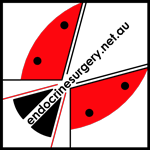Hypothyroidism
Underactivity of the thyroid is called hypothyroidism. Hypothyroidism occurs in about 5% of the adult population in Australia; most present with subclinical hypothyroidism (mild thyroid failure), characterised by raised levels of serum thyroid stimulating hormone (TSH) but normal free thyroxine (T4), but 0.5% will have overt hypothyroidism with a raised TSH and low T4 - see webpage Thyroxine Treatment for more information.
When the cause lies in the thyroid it is called primary hypothyroidism; when it is due to a lack of thyroid stimulating hormone (TSH) subsequent to pituitary failure, it is called secondary hypothyroidism.
Causes of Primary Hypothyroidism
Primary hypothyroidism results from low levels of thyroid hormones in the circulation as a direct result of an underproduction by the thyroid gland itself. The condition can be clinical or subclinical. Clinical hypothyroidism is when there are definite symptoms with a raised TSH outside the reference range and a low serum thyroxine level. Some patients have few if any symptoms, have a serum TSH outside the reference range, but have serum thyroxine levels within the reference range. These patients have subclinical hypothyroidism.
The main causes of primary hypothyroidism are:
1. Hashimoto's thyroiditis
This is the most common cause of hypothyroidism in Australia and is another example of an autoimmune disease, where the body's immune system attacks the body's own organs. It is six times more common in women than men and presents with all the symptoms of hypothyroidism. It may be associated with other endocrine deficiencies such as diabetes mellitus or Addison's disease.
The patient's thyroid feels rubbery and the thyroid function tests confirm hypothyroidism. The thyroid scan shows an irregular patchy uptake. Thyroid peroxidase antibodies in the blood confirm the diagnosis. Treatment is thyroid replacement. The condition is potentially premalignant and any suspicious nodules should be biopsied to exclude lymphoma. The thyroid swelling usually regresses on thyroid medication and surgery is very rarely indicated.
Other forms of thyroiditis such as postpartum thyroiditis, De Quervain's thyroiditis and silent thyroiditis can all cause hypothyroidism (see webpage Thyroiditis).
2. Congenital
Poor development of the thyroid, aplasia, hypoplasia or defective synthesis of thyroid hormone (dyshormonogenesis) - one in 4000 live births. In children, hypothyroidism is especially dangerous. Thyroid hormone is needed for normal growth and development of organs, especially the brain. In congenital thyroid deficiency, a condition in which the thyroid isn't functioning at birth, the child suffers from irreversible growth and mental retardation if the condition isn't recognised and treated from the beginning. Routine screening of all neonates by heel-prick blood sampling enables detection and treatment by the 10th day after birth.
3. Drugs
- Lack of iodine or grossly excessive iodine in diet (worldwide, iodine deficiency is the most common cause of hypothyroidism)
- Over treatment with antithyroid drugs in thyrotoxicosis
- Lithium treatment in mental disease
- Amiodarone treatment in heart disease
- Thalidomide
- Sunitinib
- Rifampicin
4. Loss of thyroid
- Surgical removal (post-thyroidectomy)
- Radioactive iodine treatment
Causes of Secondary Hypothyroidism
Secondary hypothyroidism results from an underproduction of thyroid hormones from the thyroid caused by deficient TSH stimulation by the pituitary. The main causes are:
- Destruction of the anterior pituitary gland due to tumour or surgery
- Very rare isolated deficiency in TSH production by the pituitary gland
- Peripheral resistance to thyroid hormones
Symptoms and signs of hypothyroidism
The symptoms and signs of hypothyroidism are often mild and subtle, tending to 'creep up' on the patient and often resulting in a delayed diagnosis. Clinical features include:
- Fatigue
- Weight gain and change in appearance with a deeper voice
- Cold intolerance & hypothermia in winter
- Joint pain (arthralgia)
- Constipation
- Menstrual irregularity
- Poor libido
- Coarse dry skin & hair, with puffy eyes
- Goitre
- Slow pulse (bradycardia)
- Leg swelling, due to heart failure
- Carpal tunnel syndrome
- Mental changes e.g. depression, myxoedema madness (in extreme cases)
- Myxoedema coma
Myxoedema Coma
When hypothyroidism is severe, it's also known as myxoedema. As hypothyroidism gets worse without treatment, there is progressive lethargy and weakness and eventually myxoedema coma is the result. This condition is common in elderly patients and has a number of possible precipitating factors:
- Surgery
- Infection
- Drugs
- Myocardial Infarction (heart attack)
- Stroke
- Hypothermia (low body temperature)
Myxoedema coma is a medical emergency requiring supportive measures and replacement of thyroid hormones.
Diagnosis of hypothyroidism
The problem with making the diagnosis is thinking of it in the first place, as it may be difficult to pick up because of its insidious onset. The symptoms and signs progress slowly over many years.
Patients with suspected hypothyroidism should have the TSH and T4 measured, and if the diagnosis is confirmed then thyroid antibodies should be tested. If there is only subclinical hypothyroidism, then the test should be repeated in 2-3 months to see if the problem persists. There is a 50:50 chance that a mildly elevated TSH (up to 10mU/L) will normalise without treatment (not after thyroidectomy, however). There is no indication for routine thyroid ultrasound in the investigation of hypothyroidism.
The importance of detecting and treating subclinical hypothyroidism remains uncertain, but levels of TSH above 10mU/L is associated with an increased risk of cardiovascular disease. The benefits of treating subclinical hypothyroidism are probably greater in younger and middle-aged patients than in older people.
In primary hypothyroidism the TSH is raised with a low T4 and T3, but in secondary hypothyroidism the TSH is also low, with a low T3 and T4.

